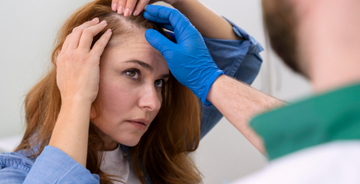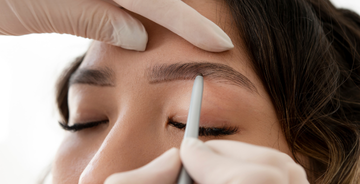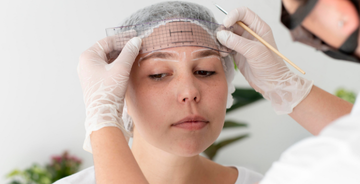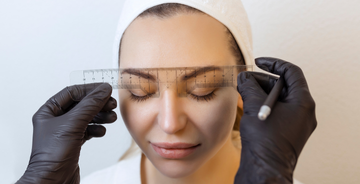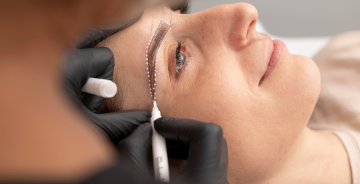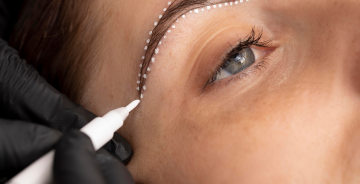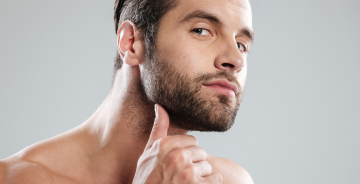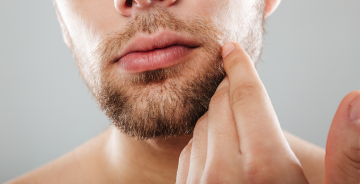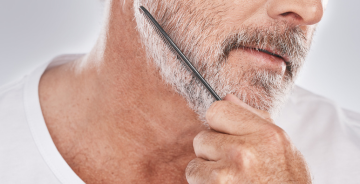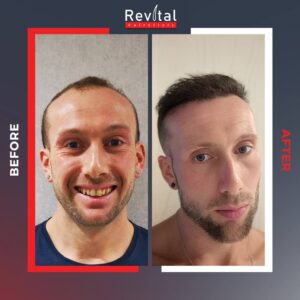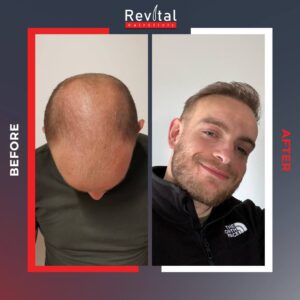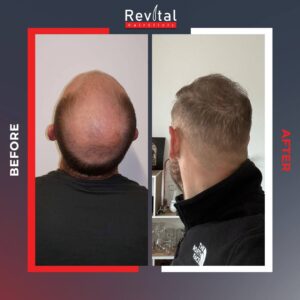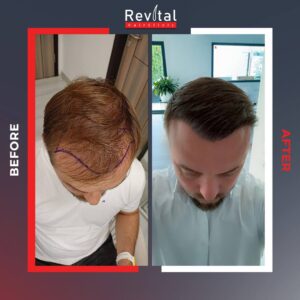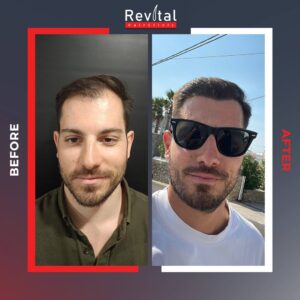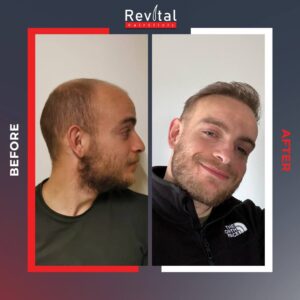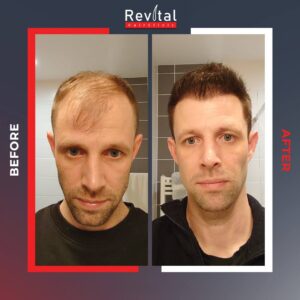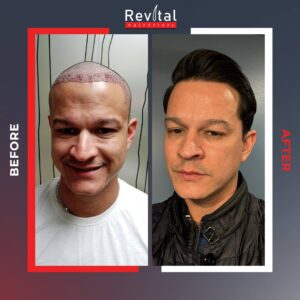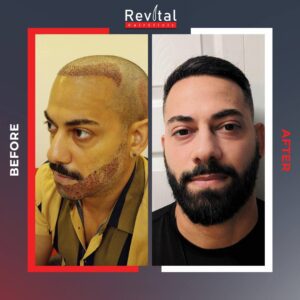Category Blog
23 Apr
Hair Transplantation for Women
Hair Transplantation for Women: Unique Challenges and Solutions Hair loss in women is often different from men’s, and it requires special considerations for hair transplantation. Challenges Women Face with Hair Loss Women typically experience diffuse thinning rather than complete baldness, which can make hair transplant planning more complicated. Additionally, factors like hormonal changes, pregnancy, and menopause can contribute to hair thinning. Hair Transplantation Solutions for Women Women’s hair transplants usually focus on restoring density rather than a full hairline restoration. Specialized techniques such as DHI can help achieve natural results for women who have thinner hair. Conclusion Hair transplantation for women can provide excellent results, but it requires a tailored approach. With the right technique and surgeon, women can achieve a natural, fuller head of hair.
READ MORE30 Sep
When Do We See the Exact Results of Eyebrow Transplantation?
When Do We See the Exact Results of Eyebrow Transplantation? Eyebrow transplantation is a popular and effective procedure for individuals looking to restore or enhance their eyebrows, whether due to overplucking, genetics, trauma, or medical conditions. While the procedure itself is relatively straightforward, many patients are curious about one thing: “When will I see the final results?” In this blog post, we’ll break down the healing timeline, explain what to expect at each stage, and provide expert tips to ensure the best possible outcome from your eyebrow transplant. A Timeline of Eyebrow Transplant Results Immediately After the Procedure (Day 0–7) The transplanted area may appear slightly red or swollen. Tiny scabs will form around the implanted grafts. You might feel some mild discomfort or tightness. Important: Avoid scratching or rubbing your eyebrows during this stage to prevent dislodging the grafts. Week 2–3: Shedding Phase (Shock Loss) This can be a bit alarming, but it’s completely normal! The newly transplanted hairs typically fall out around this time. This process is called shock loss and is expected. Don’t worry – the follicles are still intact beneath the skin. Month 1–3: Dormant Phase It may seem like nothing is happening, but the follicles are settling in and starting to regenerate. You won’t see much visible growth during this period. Patience is key – this is part of the natural hair cycle. Month 3–6: Initial Regrowth The first signs of new hair growth usually begin to appear. Hairs may be thin, fine, or even grow in at different angles at first – this is also normal. At this point, some styling or trimming may be needed as the new hairs grow. Month 6–9: Noticeable Improvement Hair growth becomes more consistent. The brows start to look fuller and more natural. You’ll see a significant improvement in density and shape. Month 9–12: Final Results By this time, you should see the final results of your eyebrow transplant. Hairs have matured, thickened, and blended in with your natural brow hair. You can treat these hairs like natural brows – trim, shape, and even tint them if desired. ✅ Tips to Maximise Your Results Follow post-op care instructions from your clinic carefully. Avoid excessive sun exposure in the first few weeks. Stay patient – hair growth takes time. Schedule follow-up appointments to monitor progress. Maintain a healthy diet to support hair health. ⚕️ Final Thoughts Eyebrow transplantation offers permanent, natural-looking results, but like any hair restoration procedure, it requires time. While you may start to notice early changes around the 3-month mark, true final results are typically visible between 9 to 12 months post-procedure. Everyone’s hair growth cycle is different, so your personal timeline might vary slightly. The key is to remain patient and consistent with aftercare – your dream brows are well on their way!
READ MORE30 Sep
When Do Transplanted Eyebrows Start to Grow?
When Do Transplanted Eyebrows Start to Grow? Eyebrow transplantation has become an increasingly popular solution for those seeking fuller, natural-looking brows. Whether you’ve experienced hair loss due to overplucking, genetics, or medical conditions, a transplant can offer permanent results. But one of the most common questions we hear from our patients is: “When will my new eyebrow hairs start to grow?” Understanding the hair growth cycle and the healing process will help set realistic expectations for what happens after your procedure. Let’s walk through the typical timeline. Understanding the Eyebrow Hair Growth Timeline Right After the Procedure (Day 0–7) The transplanted hair grafts are placed carefully into the brow area. You may notice some redness, swelling, and small scabs – all part of normal healing. Hairs are still visible at this point, but these are not yet the “real” growth. Week 2–3: Shedding Phase Around 10–20 days after the transplant, the newly implanted hairs begin to fall out. This might seem concerning, but don’t panic – it’s called shock loss and is completely normal. The hair follicles remain under the skin and are simply transitioning into a resting phase. Month 1–3: Dormant Period During this phase, you won’t see much visible growth. The follicles are adjusting and preparing to enter the active growth phase. This can be the most mentally challenging part for patients, but trust the process! Month 3–4: Early Signs of Growth Around the 3rd or 4th month, the first new eyebrow hairs begin to emerge. These hairs may appear thin, fine, and grow at slightly irregular angles initially. It’s a sign that your follicles are healthy and active! Month 5–6: More Noticeable Growth Growth becomes more visible and consistent. You’ll start to see the shape of your brows taking form. Some grooming may be required, as transplanted hairs can grow a bit longer than natural brows. Month 6–12: Full Maturity Over the next several months, the hairs will thicken, darken, and settle into a more natural appearance. By month 9–12, your transplanted brows will look and behave just like your natural ones. You can trim, shape, and even tint them as desired. ✅ Tips to Support Healthy Eyebrow Growth Stick to your post-operative care instructions: Keeping the area clean and avoiding trauma is crucial. Be patient: Everyone’s growth rate is different based on hair cycle, skin type, and overall health. Avoid makeup or harsh skincare products on the brow area for at least a few weeks. Stay hydrated and maintain a balanced diet to support hair health. ⚕️ Final Thoughts Transplanted eyebrow hairs usually start to grow around the 3rd or 4th month post-procedure. Although it might seem like a long wait, the results are absolutely worth it. With time, care, and a bit of patience, your new brows will become fuller, natural-looking, and permanent. If you have any questions or want to learn more about the eyebrow transplant journey, don’t hesitate to contact our team at Revital Hair Clinic. We’re here to guide you every step of the way.
READ MORE30 Sep
What Should Be Known Before Eyebrow Transplantation?
What Should Be Known Before Eyebrow Transplantation? Eyebrow transplantation is a life-changing procedure for many individuals who desire fuller, well-shaped, and natural-looking eyebrows. Whether you’ve lost eyebrow hair due to genetics, trauma, over-plucking, or medical reasons, a transplant can offer a long-lasting solution. However, before you decide to undergo the procedure, there are several important points you should know. Being well-informed can help you set realistic expectations, reduce anxiety, and ensure a smooth process from consultation to final results. 1. Understand How the Procedure Works Eyebrow transplantation typically involves using the FUE (Follicular Unit Extraction) technique, where individual hair follicles are harvested—usually from the back of the scalp—and transplanted to the brow area. The procedure is minimally invasive and done under local anesthesia. The hairs are carefully implanted one by one, following the natural growth direction and desired shape. The entire process can take a few hours, depending on the number of grafts required. 2. A Consultation is Crucial Before the procedure, a detailed consultation with a qualified hair transplant specialist is essential. During this session, you will: Discuss your expectations and desired eyebrow shape. Learn whether you’re a suitable candidate (based on skin type, hair texture, health conditions, etc.). Receive a personalized treatment plan. Get information on pricing and recovery. 3. The Donor Area Matters The most common donor area is the back of the scalp, as it contains strong and resistant hair follicles. These hairs may grow longer than natural brow hair, so occasional trimming is often required post-transplant. If you have limited scalp hair, other body areas may be considered, but this is less common. ⏳ 4. Results Take Time One of the most important things to understand is that results are not immediate. The transplanted hairs often fall out in the first few weeks (a normal part of the process known as “shock loss”). New hairs begin to grow around month 3 or 4. Final results are typically seen within 9–12 months. Patience and consistency with aftercare are key! 5. There Are Some Temporary Restrictions After your procedure, you’ll need to follow some basic care guidelines to protect the grafts and support healing. Avoid rubbing, scratching, or applying makeup to the area for at least 7–10 days. Stay away from saunas, intense workouts, or swimming during the first week. Follow all post-op instructions given by your clinic. ⚖️ 6. Know the Risks and Limitations While eyebrow transplants are generally safe and successful, it’s important to know: There may be slight asymmetry or uneven growth at first. Not all transplanted hairs may survive (though survival rates are usually high with a skilled surgeon). A touch-up session may sometimes be needed after 8–12 months to perfect the results. Choosing an experienced clinic significantly reduces these risks. Final Thoughts Before getting an eyebrow transplant, it’s essential to educate yourself about the process, timeline, expectations, and aftercare. A successful result depends not just on the skill of your surgeon but also on how prepared and informed you are as a patient. If you’re considering an eyebrow transplant, our team at Revital Hair Clinic is here to guide you with expert care and personalized advice. Feel free to book a consultation and take the first step toward your dream brows!
READ MORE30 Sep
Eyebrow transplantation is usually performed for the following reasons
Eyebrow Transplantation Is Usually Performed for the Following Reasons Eyebrows play a vital role in framing the face, expressing emotions, and enhancing overall facial aesthetics. But not everyone is naturally blessed with thick, symmetrical brows. Over the years, eyebrow transplantation has emerged as a popular solution for restoring or enhancing eyebrow density and shape. But who is this procedure really for? In this article, we’ll explore the most common reasons people seek eyebrow transplantation, helping you understand if it might be the right option for you. 1. Overplucking or Waxing Damage One of the most frequent causes of thinning eyebrows is repeated overplucking, tweezing, or waxing—especially during the 90s and early 2000s when thin brows were in fashion. Over time, constant hair removal can damage the hair follicles permanently, preventing regrowth. Eyebrow transplantation helps restore natural density where hair no longer grows on its own. 2. Genetic or Naturally Sparse Eyebrows Some individuals are simply born with sparse or uneven eyebrow hair due to genetics. If you’ve always had thin brows and never managed to grow them out fully, this is likely genetic. Transplantation can help you achieve the fuller look you’ve never had but always wanted. 3. Medical Conditions or Treatments Several health conditions or medical treatments can cause eyebrow hair loss, including: Alopecia areata Hypothyroidism Chemotherapy or radiation Skin disorders such as eczema or psoriasis affecting the brow area In many of these cases, once the condition is stabilized, eyebrow transplantation becomes a viable solution to restore lost hair and confidence. 4. Scarring or Trauma Accidents, burns, surgeries, or even cosmetic tattooing gone wrong can lead to scar tissue where eyebrow hair no longer grows. Transplantation can be performed on scarred areas, provided there’s healthy skin and blood supply. It’s an effective way to conceal scars and create a natural brow appearance. 5. Cosmetic Enhancement and Brow Shaping Not everyone who gets an eyebrow transplant has experienced hair loss. Many individuals opt for the procedure purely for aesthetic reasons: To enhance or reshape their natural brow arch To fill in gaps or asymmetry To achieve a specific brow style (e.g., thicker, more defined brows) Eyebrow transplantation offers long-term results compared to daily makeup or temporary tinting. ⚕️ 6. Failed Microblading or Tattooing While microblading and brow tattoos can offer semi-permanent results, they often fade, change color, or appear unnatural over time. Eyebrow transplantation uses your own natural hair, creating a much more realistic and permanent outcome. It’s also a great corrective procedure for those unsatisfied with previous cosmetic brow treatments. ⚕️ Final Thoughts There are many reasons why someone might consider eyebrow transplantation—ranging from medical necessity to purely aesthetic choice. What they all have in common is the desire for fuller, natural-looking, and long-lasting eyebrows. At Revital Hair Clinic, we take a personalized approach to every patient’s needs and goals. Whether you’re recovering from hair loss or simply want to enhance your look, we’re here to guide you every step of the way. If you’re wondering whether eyebrow transplantation is right for you, feel free to book a consultation with our experts today.
READ MORE30 Sep
In Which Situations Is Eyebrow Transplantation Performed?
In Which Situations Is Eyebrow Transplantation Performed? Eyebrow transplantation is a highly effective solution for individuals who are unhappy with the density, shape, or symmetry of their eyebrows due to various underlying reasons. This surgical procedure provides permanent, natural-looking results, but it’s not only about aesthetics—it is also performed in response to medical, genetic, and trauma-related conditions. So, in what situations is eyebrow transplantation considered appropriate or necessary? Let’s take a closer look at the most common scenarios. 1. Permanent Eyebrow Hair Loss One of the primary indications for eyebrow transplantation is permanent loss of eyebrow hair, which may result from: Scarring from burns or accidents Surgical scars Infections that have damaged hair follicles Radiation therapy or certain medications In these cases, eyebrow hair doesn’t grow back naturally, and transplantation offers a reliable solution to restore the appearance of the brows. 2. Congenital (Genetic) Thin or Absent Eyebrows Some individuals are born with sparse, patchy, or even completely absent eyebrows due to genetics or developmental conditions. In such cases, eyebrow transplantation is performed to create a brow shape that was never present before, offering a major improvement in facial harmony and confidence. 3. Overplucking and Cosmetic Damage Excessive tweezing, waxing, or threading over the years can lead to irreversible damage to eyebrow hair follicles. This is especially common among individuals who followed the thin eyebrow trend in the past and are now struggling to regain volume. Transplantation is an ideal way to rebuild natural, fuller brows where hair no longer grows on its own. ⚠️ 4. Medical Conditions Several health conditions can cause partial or complete eyebrow loss. These include: Alopecia areata Thyroid disorders (like hypothyroidism) Lupus Trichotillomania (a psychological condition where a person compulsively pulls out hair) Nutritional deficiencies Once the underlying condition is treated or stabilized, an eyebrow transplant may be considered to restore brow hair in affected areas. ️ 5. Unsatisfactory Results from Cosmetic Procedures Many patients come to us after being dissatisfied with the outcome of: Microblading Eyebrow tattoos Semi-permanent makeup While these options offer temporary improvement, they can sometimes lead to unnatural appearances, discoloration, or even scar tissue. Eyebrow transplantation provides a permanent, natural, and customizable alternative. 6. Aesthetic and Personal Preferences Not all eyebrow transplants are performed due to loss or damage. Many patients simply desire: A fuller or more defined eyebrow shape Correction of asymmetrical brows A more youthful and expressive facial appearance In such cases, transplantation is an elective cosmetic procedure aimed at enhancing self-confidence and beauty. ⚕️ Final Evaluation by a Specialist Is Key While eyebrow transplantation can be beneficial in many situations, it’s important to note that not everyone is a candidate. Factors such as skin condition, available donor hair, overall health, and realistic expectations all play a role. A comprehensive consultation with a qualified hair transplant specialist will help determine: If transplantation is suitable for you What techniques will be used What kind of results you can expect Final Thoughts Eyebrow transplantation is a versatile and effective procedure performed in a variety of situations—from medical necessity to cosmetic enhancement. If you’re experiencing eyebrow thinning, loss, or dissatisfaction with your current brow appearance, a personalized treatment plan can make all the difference. At Revital Hair Clinic, our experienced team is here to help you understand your options and achieve long-lasting, natural results. Book a consultation today and take the first step toward brows you’ll love.
READ MORE30 Sep
Eyebrow Transplant
Everything You Need to Know Eyebrows are one of the most defining features of the face. They express emotion, enhance facial symmetry, and contribute significantly to your overall appearance. But due to factors like overplucking, genetics, trauma, or medical conditions, many people experience eyebrow thinning or complete loss. Fortunately, there’s a permanent solution: eyebrow transplant. In this guide, we’ll walk you through what an eyebrow transplant is, how it works, who it’s for, and what you can expect before, during, and after the procedure. What Is an Eyebrow Transplant? An eyebrow transplant is a minimally invasive surgical procedure that involves transplanting hair follicles—typically from the back of the scalp—into the eyebrow area to restore fullness, shape, and symmetry. The process typically uses the FUE (Follicular Unit Extraction) technique: Individual hair follicles are harvested one by one from the donor area. These follicles are then implanted into the brow region with precision, following the natural direction and angle of eyebrow hair. ⚕️ Who Is a Good Candidate? Eyebrow transplantation may be suitable for individuals who: Have naturally thin or sparse eyebrows Have lost brow hair due to overplucking, trauma, burns, or surgery Suffer from medical conditions such as alopecia or thyroid disorders Want to enhance the shape or thickness of their brows for cosmetic reasons Are unhappy with the results of microblading or permanent makeup A consultation with a qualified hair restoration specialist is essential to determine eligibility. ⏱️ What Does the Procedure Involve? Here’s a brief overview of what to expect: Consultation & Design Brow shape, thickness, and symmetry are discussed and designed based on your facial structure and preferences. Donor Hair Extraction Hair follicles are usually harvested from the back of your head, where hair growth is dense and durable. Implantation The extracted follicles are carefully implanted into the brow area, one by one, with meticulous attention to direction and depth. Recovery Minimal downtime—most people return to work in 1–2 days. Tiny scabs form and fall off within a week. When Will I See Results? Weeks 2–3: Transplanted hairs fall out (shock loss – normal part of the cycle). Months 3–4: New hairs begin to grow. Months 6–9: Brows look fuller and more defined. Months 9–12: Final results are visible – natural, full, and permanent eyebrows. ✅ Advantages of Eyebrow Transplant Permanent results – no need for daily filling or tinting Natural appearance, as your own hair is used Customizable to fit your facial features and aesthetic goals A confidence boost with long-lasting satisfaction Things to Consider Before Getting an Eyebrow Transplant You may need to trim transplanted hairs regularly, as they grow like scalp hair. Not all follicles may survive—touch-up sessions may be necessary in rare cases. Choosing an experienced clinic and surgeon is key to natural-looking results. Final Thoughts An eyebrow transplant is a safe, effective, and permanent solution for achieving naturally full and well-shaped eyebrows. Whether you’ve lost your brows or simply want to enhance them, the results can be life-changing—boosting both your appearance and self-confidence. At Revital Hair Clinic, we specialize in personalized eyebrow restoration tailored to your unique facial features and goals. Contact us today to book your consultation and start your journey toward perfect brows!
READ MORE30 Sep
How Long Does Beard Transplantation Take?
How Long Does Beard Transplantation Take? Beard transplantation has become an increasingly popular option for men who wish to achieve a fuller, well-defined, and symmetrical beard. Whether you’re dealing with patchy growth, scarring, or a lack of facial hair due to genetics, this procedure can transform your look permanently. But one of the most common questions we get is: “How long does beard transplantation actually take?” Let’s break it down—from the day of the procedure to full recovery and final results. ⏱️ How Long Does the Procedure Itself Take? The beard transplant procedure typically takes between 4 to 8 hours, depending on several factors: The number of grafts required (usually between 1,500–3,000) Whether it’s a full beard, goatee, mustache, or sideburns The technique used (FUE is the most common and modern method) What to Expect During the Procedure: You’ll be under local anesthesia, so the process is virtually painless. Hair follicles are usually harvested from the back or sides of the scalp. Grafts are then meticulously implanted into the beard area, one by one, in the desired shape and density. What About Recovery Time? Recovery after a beard transplant is relatively quick and straightforward. First 3 Days: Redness, mild swelling, and tiny scabs in the implanted area. You’ll need to avoid touching or washing the beard area. Day 4–7: Most scabs start falling off. You can gently wash your face with clinic-recommended products. Many people feel comfortable returning to work within a few days. Week 2: The transplanted hairs may begin to fall out—this is completely normal and part of the shock loss phase. When Does New Hair Start to Grow? Months 2–3: New beard hairs begin to emerge from the follicles. Months 4–6: Noticeable improvement in thickness and shape. Months 9–12: Final results become visible. The beard looks natural, full, and can be shaved and styled just like normal facial hair. Timeline Summary Stage What Happens Procedure Day 4–8 hours total Day 1–7 Healing, scabbing, minor swelling Week 2–3 Shedding phase begins (normal) Month 3–4 New hairs start to grow Month 6–9 Beard looks fuller and denser Month 12 Final results are achieved ⚕️ Tips to Speed Up Recovery and Growth Follow all post-op instructions provided by your surgeon. Avoid heavy sweating, direct sun exposure, and shaving the area for the first few weeks. Maintain a balanced diet rich in vitamins (especially biotin and zinc). Avoid smoking and alcohol during the recovery phase—they can slow healing. Final Thoughts So, how long does beard transplantation take? ➡️ The procedure itself lasts a single day, but the full process—from healing to seeing the final results—can take up to 12 months. It’s a journey that requires patience, but the results are permanent, natural, and worth the wait. At Revital Hair Clinic, we specialize in beard restoration using advanced FUE techniques to ensure precise, natural-looking outcomes. If you’re ready to take the first step toward the beard you’ve always wanted, contact us today for a personalized consultation.
READ MORE30 Sep
Who is Suitable for Beard Transplantation?
Who Is Suitable for Beard Transplantation? A well-groomed, full beard has become a powerful symbol of masculinity, style, and confidence. However, not every man is naturally able to grow a dense and even beard. Beard transplantation has become an increasingly popular solution—but it’s important to understand that not everyone is an automatic candidate for the procedure. So, who is suitable for a beard transplant? Let’s take a closer look at the ideal candidates, medical considerations, and factors that determine eligibility. ✅ Ideal Candidates for Beard Transplantation You may be a good candidate for a beard transplant if: 1. You Have Naturally Sparse or Patchy Facial Hair Some men simply can’t grow a full beard due to genetic reasons. If you’ve always had thin or uneven beard growth despite age or hormonal balance, a transplant can help you achieve the look you want. ✂️ 2. You Have Scars or Hair Loss Due to Injury or Surgery Beard transplants are highly effective for covering scars caused by: Acne Surgical procedures Burns or trauma In such cases, follicles can be implanted directly into the scar tissue (if it has proper blood supply). 3. You Want to Reshape or Redefine Your Beard Even if you already have facial hair, you might want: A more defined beard line A thicker goatee or mustache To connect patches, like the cheeks to the chin Beard transplants are fully customizable and can be designed to match your facial structure and aesthetic preferences. 4. You’ve Lost Hair Due to Medical Conditions Certain health conditions can lead to facial hair loss, including: Alopecia areata Hormonal imbalances Trichotillomania (hair-pulling disorder) Post-chemotherapy recovery Once the underlying condition is stable or treated, a beard transplant can be considered. Who May Not Be Suitable? While many people qualify, there are some conditions or limitations that might delay or prevent the procedure: ❌ Inadequate Donor Hair Beard transplants require strong, healthy donor follicles, usually from the scalp (back or sides). If you have severe hair thinning or baldness, there may not be enough donor hair. ❌ Active Skin Conditions If you have active infections, dermatitis, or uncontrolled acne in the beard area, these need to be resolved before any transplant can be done. ❌ Unrealistic Expectations If you expect instant or overly dramatic results, it’s important to understand that beard growth is gradual, and final outcomes may take 6 to 12 months to fully develop. What Happens During the Evaluation? At your initial consultation, your specialist will assess: Beard growth pattern and density Skin condition in the facial area Donor hair quality and quantity Overall health and medical history Your goals and expectations Based on this, a custom treatment plan will be created for you. ⚕️ Final Thoughts Beard transplantation is a highly effective, permanent solution for men who struggle with patchy, thin, or non-existent facial hair. Whether the issue is genetic, medical, or cosmetic, many individuals are excellent candidates for the procedure. The best way to find out if you’re suitable is to book a professional consultation. At Revital Hair Clinic, we offer personalized assessments to determine the best approach for your desired look. Your perfect beard could be just a step away. Contact us today to get started.
READ MORE30 Sep
Is Beard Transplant Permanent?
Is Beard Transplant Permanent? For many men, growing a thick, even beard is not just about style—it’s a statement of personality, confidence, and masculinity. Beard transplantation offers a long-term solution for those with sparse, patchy, or no facial hair. But before committing to the procedure, one crucial question often comes up: “Is a beard transplant permanent?” The short answer is: Yes — with the right technique and care, beard transplant results are permanent. Let’s dive deeper into why that’s the case and what you should expect long-term. How Does a Beard Transplant Work? Beard transplants are typically done using the FUE (Follicular Unit Extraction) method. Here’s how it works: Hair follicles are taken from the donor area (usually the back or sides of the scalp). These follicles are then carefully implanted into the beard area, following natural angles and growth patterns. Once transplanted, the follicles establish themselves in their new location and begin producing hair just like they did in the donor area. This is key: since the follicles come from a part of the scalp that’s genetically resistant to hair loss, they retain this resistance even after being moved to the face. ✅ So Yes, Beard Transplants Are Permanent — But… While the hair follicles themselves are permanent, certain factors can affect long-term results: ✔️ Initial Shedding Is Normal 2–3 weeks after the procedure, the transplanted hairs usually fall out (this is known as shock loss). This does not mean the transplant failed! The follicles remain intact, and new hair starts growing around month 3. ✔️ Final Results Take Time The full, natural beard appearance typically develops over 9 to 12 months. Once the hairs grow in fully, you can trim, shave, and style them just like natural beard hair. ✔️ Quality Depends on the Clinic and Technique Poor surgical technique or lack of post-operative care may impact follicle survival. Choosing an experienced, reputable clinic is key to ensuring lasting and natural results. Will I Need a Second Session? Most patients achieve excellent density in a single session. However: If you’re seeking a very thick or full beard, or If not all grafts survive due to skin type or scarring, …a touch-up session may be recommended 9–12 months after the first procedure. This is not due to the hair falling out, but to improve density and fill any minor gaps. Tips to Ensure Long-Term Results Follow all post-op care instructions from your doctor. Avoid scratching, shaving, or disturbing the area for at least 10 days. Keep a healthy lifestyle, as overall health can influence hair quality. Choose a clinic that uses modern FUE techniques and experienced specialists. ⚕️ Final Thoughts So, is beard transplant permanent? ➡️ Yes, it is. The transplanted hairs are here to stay, and with proper care, they will grow naturally for a lifetime. A beard transplant is not just a cosmetic procedure—it’s an investment in your confidence and appearance. At Revital Hair Clinic, we’re committed to delivering results that not only look great but also last. Book your consultation today and take the first step toward your forever beard.
READ MORERevital Hair Clinic © 2024

